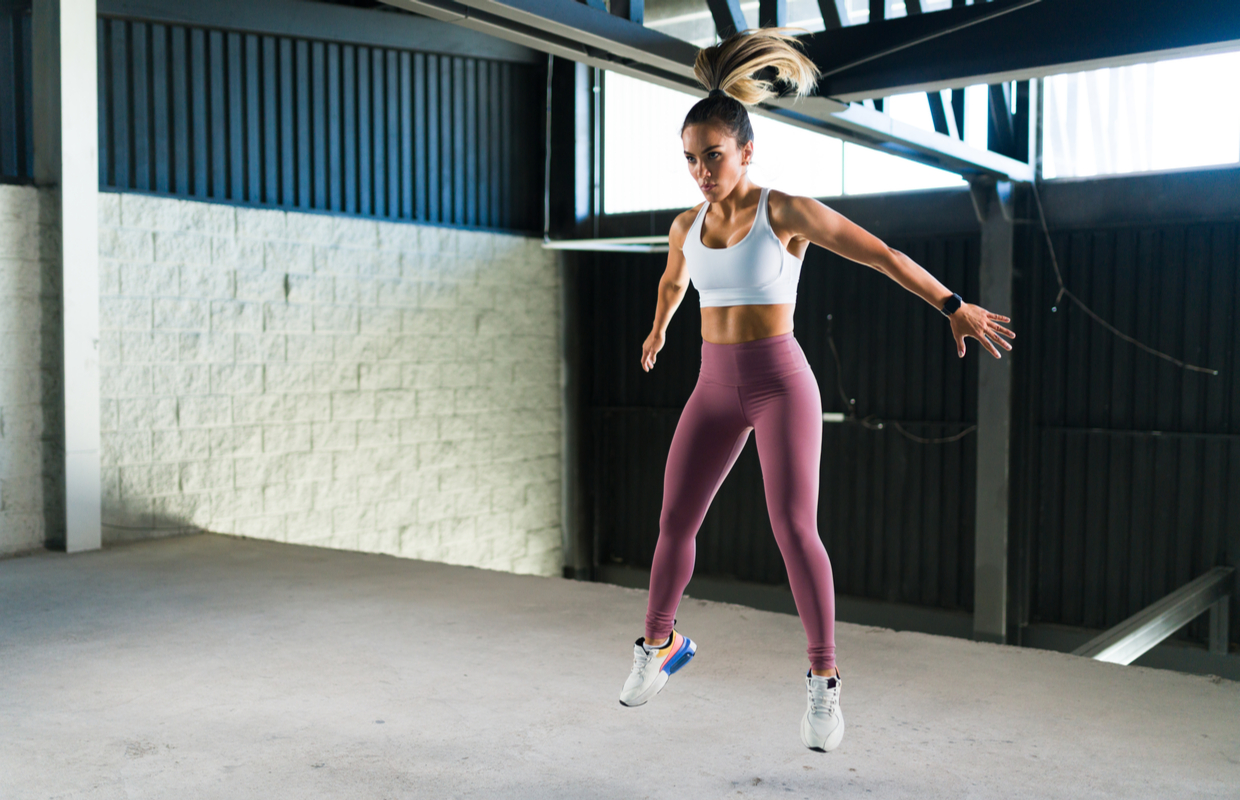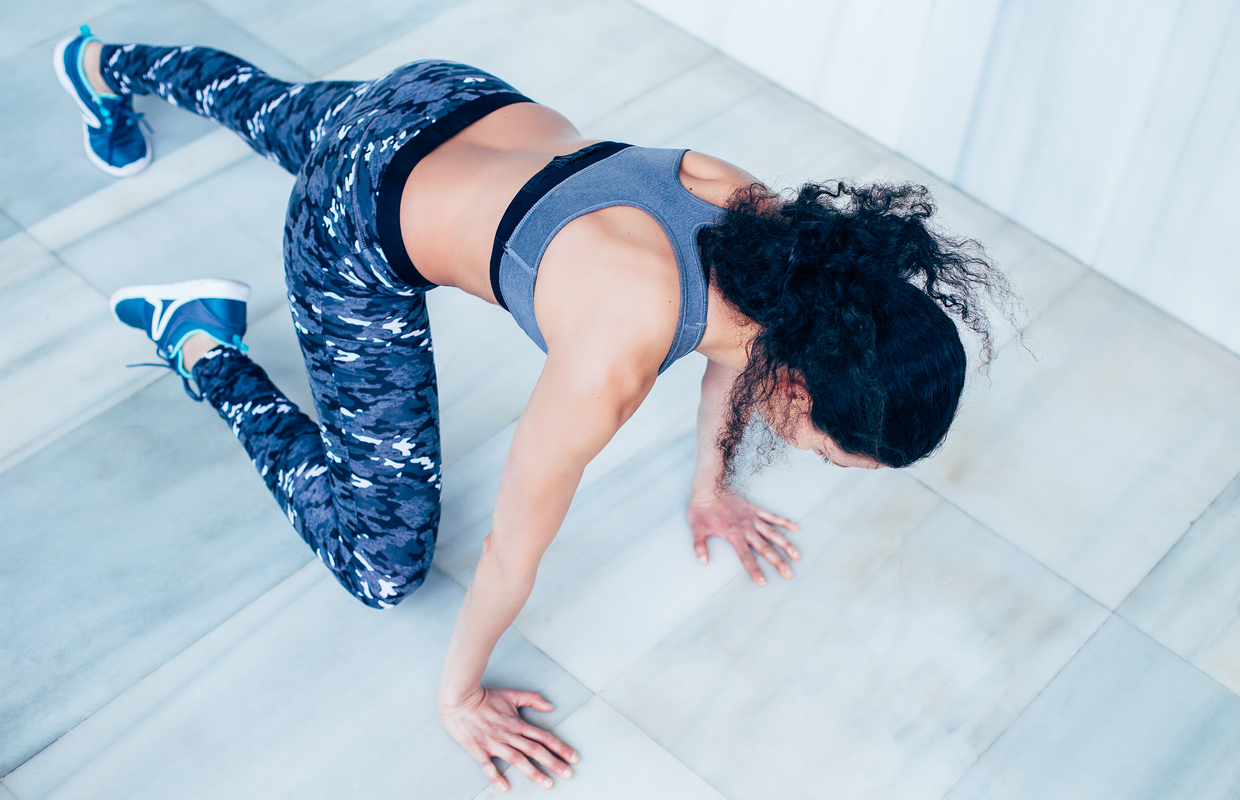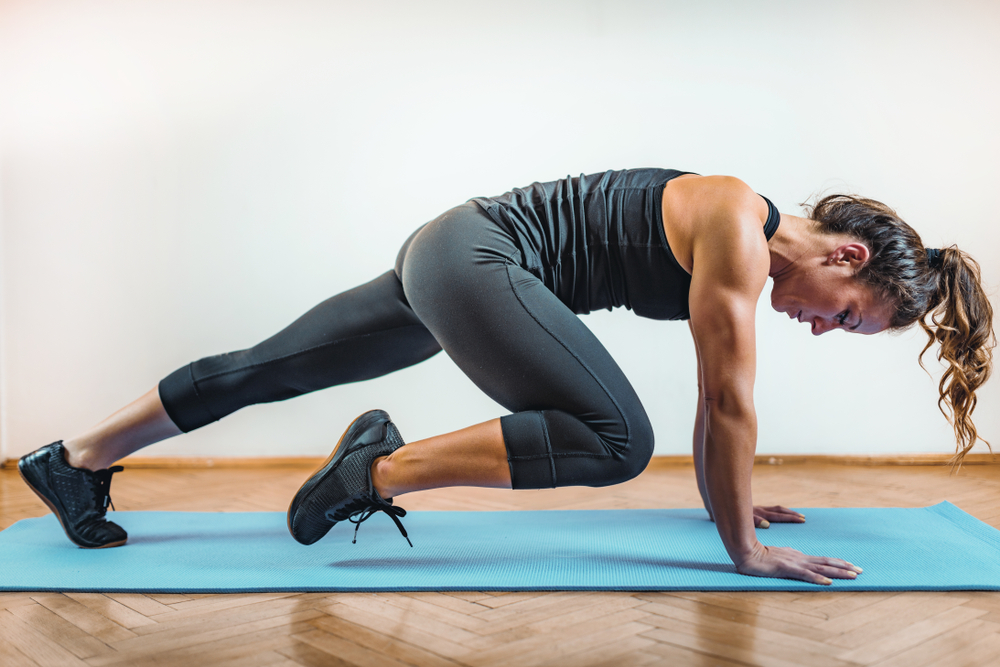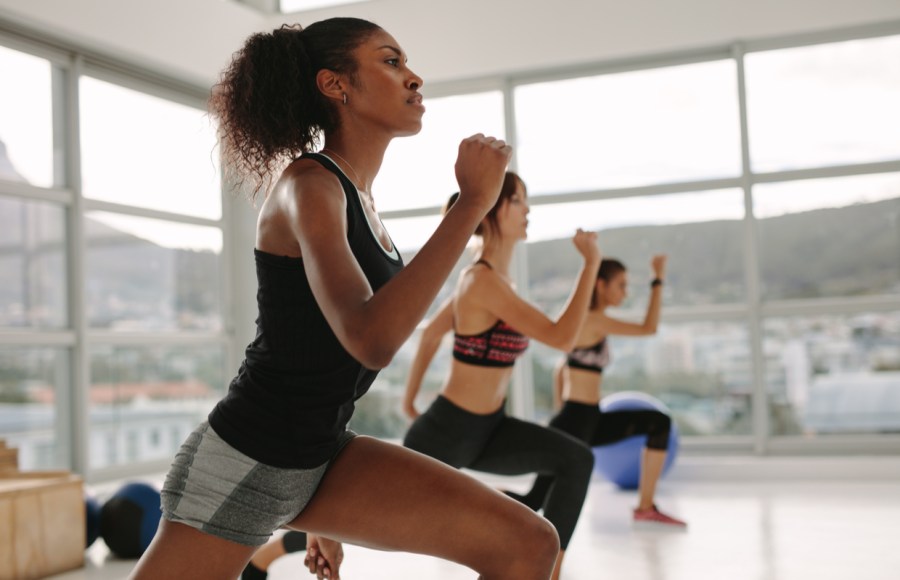HIIT (a.k.a. High Intensity Interval Training) promises a huge range of science-backed benefits for your health and fitness – but what exactly is a HIIT workout? And what can you expect from a HIIT class? We’re putting HIIT under the microscope to explore why this fitness phenomenon has become so popular, before sharing some top tips for beginners who are looking to get started with this sweaty workout…
High intensity interval training – or HIIT – is the crème de la crème of the fitness world, the ultimate challenge for exercise fans. It’s so popular, it topped the American College of Sports Science list of global fitness trends and has monopolised the fitness community ever since. But what is a HIIT workout? And is it right for you?
Chances are you’ve tried a HIIT workout, whether it’s CrossFit, P90X, Insanity or track work. Or, if you haven’t, then this beginner’s guide to HIIT will rock your workout world. HIIT is the solution to your workout woes – it incinerates excess fat, skyrockets stamina and bolsters a multitude of cardiovascular health markers. And it does all this in a handful of minutes each week. The catch? Those minutes hurt.
What is a HIIT workout?
Not heard of HIIT? Just think of it as your one-workout answer to reaching your healthy weight and peak fitness in weeks. While most cardio activities involve exercising at a moderate intensity (think seven out of 10 in terms of difficulty level, or going for a gentle jog), HIIT involves sweating it out at a higher – much higher – intensity. In fact, true HIIT efforts are performed at 80-95 percent of maximal aerobic capacity. In other words, moving like your life depends on it.
Fortunately, you do get a rest between hard HIIT intervals. The official HIIT formula combines intense workout efforts, ranging from five seconds to eight minutes at 80-95 per cent MHR, with recovery periods at 40-50 per cent MHR. During the rest period, you get to catch your breath and feel your heart rate return to normal. Ah-ha, there’s your silver lining!

Evidence-backed benefits of HIIT
HIIT is a type of cardio activity that’s firmly rooted in scientific evidence. Professor Izumi Tabata pioneered aversion of HIIT in 1996 when he got Olympic speed-skaters to combine 20 seconds of super-intense exercise with 10 seconds of rest, for four minutes in total. Results showed the Tabata HIIT group boasted greater gains in VO2 max (the body’s ability to use oxygen, and a good marker of fitness) than skaters doing steady-state training methods.
That in itself is pretty impressive but, more recently, HIIT has come to the fore as a great way to achieve the sort of endurance benefits you’d expect to gain from a long bike ride or easy training run. A pioneering study at McMaster University in Canada had students ride a bike three times a week for a fortnight. One group did HIIT-style intervals of 20-30 seconds combined with four minutes’ rest, four to six times, while another pedalled away at a comfy pace for 90-120 minutes.
Amazingly, results showed the two groups reaped a similar increase in endurance – it’s just that one group had spent six to nine minutes on the gym bike each week and the other had clocked up a rather unsociable five hours. Sounds like the HIIT exercisers got the best deal? Sure, they probably did but those nine minutes had to feel like hell.
HIIT for healthy weight loss
Yes, HIIT is tough – but scientific evidence shows it burns more calories per minute than any steady-paced workout. One study even reports exercisers burnt a whopping 15 calories per minute doing HIIT, while another shows women on a 15-week HIIT plan boasted an impressive drop in total body fat, and reductions in stubborn subcutaneous leg and trunk fat. This is because HIIT improves the body’s ability to use energy anaerobically (without oxygen). It burns oodles of calories as it revs up the heart rate and pumps blood quickly to working muscles.
While steady-state exercise – jogging, aerobic classes, long swims – uses slow-twitch muscle fibres that contract slowly and release energy gradually, HIIT recruits fast-twitch fibres that produce mighty bursts of energy and need hordes of fuel to do it. The result? Your body uses more energy, or burns more calories, and you earn greater weight management results. Of course, there’s a little more to it than that, as HIIT also causes your body to burn calories after a workout, but we’ll give you more on that later.
How HIIT improves your fitness and performance
If you’ve been exercising for yonks and have stopped noticing results, HIIT is your go-to workout. How come? You can’t keep doing the same old workout and improve athletically. The human body gets used to a certain level of exercise pretty quickly. And when that happens, you have to crank up the intensity to continue reaping fitness rewards.
HIIT is so intense that experts claim just 10 minutes of a HIIT workout accounts for 20 minutes of low-to-moderate exercise. It’s a matter of quality over quantity – intense intervals are thought to be as good as moderate cardio for boosting VO2 max energy efficiency (your body’s ability to get glucose to the muscles), fat burn and anaerobic performance.
Further research shows that high-intensity training is an effective replacement for traditional aerobic workout methods. An interesting 2008 study by Professor Martin Gibala reveals that a mere two and a half hours of sprint interval training produces similar biochemical muscle changes and endurance performance benefits as 10 and a half hours of traditional stamina work. It doesn’t get much more impressive than that.
Does HIIT boost your metabolism?
Heard of the elusive “after-burn” effect, aka cranking up your metabolism and burning excess fat for hours after a workout? Guess what – it isn’t an exercise myth. Research from the University of New Mexico shows high-intensity training will raise your resting metabolic rate (RMR) and continue to burn calories for at least two hours after you’ve completed the workout.
High-intensity training pushes your body to the max and it can take days for your RMR to return back to normal. In fact, research from the University of Wisconsin found that participants’ metabolic rates were elevated for a massive 39 hours post-workout.
Scientists call this a rise in EPOC – or excess post-exercise oxygen consumption – and it occurs because your body has to work twice as hard after a HIIT session to replenish its oxygen stores, remove lactate from your muscles and bring your body temperature back to normal. HIIT is so effective, in fact, that another study reports that exercisers experience 13 per cent more EPOC after HIIT than with any other high-intensity workout.

7 health and fitness benefits of HIIT
Now we all know what a HIIT workout is, let’s take a closer look at those all-important health and fitness benefits…
1. HIIT is great for healthy weight management
The combination of high-intensity exercise with low-to-moderate intervals is a quick way to reach your healthy weight. Put simply, the more calories you burn, the more excess weight you lose – and working out strenuously burns a lot of calories.
This is mainly because intense activity recruits fast-twitch muscle fibres, which use up lots of fuel producing powerful bursts of energy. However, research shows exercisers continue to use up energy after a hard workout, as the body burns calories replenishing oxygen stores, removing lactate from the muscles and restoring body temperature.
2. HIIT workouts are time-efficient
Forget every excuse you’ve ever conjured up! Norwegian scientists have discovered that you can compress all your exercise into a few minutes and reap greater aerobic results with HIIT. All activities – cycling, circuit training, running – rely on getting blood to working muscles, and the greater your stroke volume (the amount of blood your heart pumps out with each beat), the better your aerobic ability.
But you don’t have to plod on the treadmill for hours to reap benefits – the Norwegian research shows that an eight-week programme of three times a week HIIT sessions comprising four, four minute runs at 90-95 per cent of heartrate maximum (HR max) and three minutes of active recovery resulted in a 10 per cent greater improvement in stroke volume than long, slow distance training.
3. HIIT improves your heart health
We know what you’re thinking. Is pushing your body to the limit good for your health? While you may feel as though your heart is racing, intense exercise protects against coronary heart disease and strengthens your heart.
Research in the American Journal of Physiology reveals that high-intensity exercise at 90-95 per cent of maximal oxygen consumption (or VO2 max, your maximum rate of oxygen consumption during activity) increased left ventricle heart mass by as much as 12 per cent.
The all-out exercise approach also improved cardiac contractility by an even bigger 13 per cent. While the net result is a sturdier ticker and greater cardiovascular health, new exercisers should see their GP about heart and other health issues before beginning a HIIT programme.
4. Research shows that girls are good at HIIT
Let’s hear it for the girls! Scientists from the US recently discovered that women respond well to high intensity interval running. During the experiment, male and female runners hit the treadmill to do six, four-minute intervals at the highest intensity they felt possible.
While the men ran fastest, the women worked out harder – that is, at a higher percentage of their HR max and VO2 max – proving that the girls are good at pushing themselves to the max. Of course, you knew that already.
5. HIIT improves your immunity and wards off disease
When it comes to boosting your health, exercise is a no-brainer, but did you know that strenuous interval training can make as great a difference to your health as aerobic activities such as going for a long run but in far less time.
Research in The Journal of Physiology shows that three weekly sprint interval training sessions, totalling 90 minutes, are as effective as five endurance sessions, amounting to five hours, at increasing whole body insulin sensitivity – ultimately, lowering the risk of diabetes, hypertension and blood vessel disease.
6. HIIT is fun (yes, really!)
If your idea of a good gym session involves strolling on the treadmill, high intensity training is going to shake up your workout world. We’re not talking about a workout you can go into half-heartedly – HIIT takes focus, determination and a willingness to be challenged. There’s no time to zone out or have a chat, and you certainly don’t have the chance to get bored.
This perhaps explains why researchers at the University of Birmingham claim participants in a pilot study found high intensity training (HIT) on a spin bike more enjoyable than endurance work. The pain feels sooo good.
7. You can do HIIT workouts at home
In 2013, the prestigious American College of Sports Medicine (ACSM) introduced the world to the “seven-minute workout”, which comprised 12 exercises that could be completed in less than 10 minutes. Sounds good – right? It gets better. Using the high intensity circuit training concept (also know as HICT, and a form of high-intensity training), ACSM experts devised a workout that needed nothing more than bodyweight, a chair and a wall.
The message? You don’t need any equipment, or even a lot of space, to do a HIIT session. Squat jumps, on-the-spot sprinting and step-ups rev up your heart rate as well as any cardio machine, so grab your workout togs, plus a whole lotta determination – and get moving!

Is HIIT right for me?
Wondering whether you should add HIIT workouts to your training regime? Take a look at some of the following FAQs to work out whether HIIT is right for you…
Can I do HIIT everyday?
Newsflash – HIIT is hard. It floods your body with lactic acid, uses up fuel stores and puts a lot of stress on your muscles and connective tissues. High impact HIIT puts a lot of stress on your joints, and daily sessions will make you far more prone to joint or muscle injury. Your muscles have to contract faster and ground reaction force is much higher than during other activities, so it’s not the kind of training you can do day in-day out.
Get your body used to high-intensity exercise by starting with one HIIT training session a week and gradually increase to two weekly workouts. Give your body a chance to recover between workouts by allowing at least 48 hours between HIIT sessions. Even when you’re super-fit, don’t do HIIT more than four times a week, unless you want to injury or illness problems.
Is HIIT suitable for fitness beginners?
HIIT is the perfect workout for someone whose fitness routine is getting a bit ho-hum. But for those who are new to exercise, not so much. If you haven’t conditioned your body to deal with ample amounts (20-60 minutes) of aerobic exercise, you’re not ready for HIIT. Endurance forms the solid foundation on which you can build shorter, harder efforts. Without it, you’ll start to burn out.
Unconditioned exercisers will also lack kinesthetic awareness (exercise technique) and central nervous system development. Put simply, newbies run the risk of getting injured because their technique is being compromised during high-intensity activity. Spend some time getting to grips with basic strength and aerobic training before adding HIIT to your routine.
Am I too old for HIIT?
Sure, HIIT isn’t the number one activity for seniors. As people age, they tend to scale down on intense forms of exercise because it takes a lot longer for their body to recover between workouts. Many seniors shy away from HIIT because they fear they’ll get injured or it will be too tough. But studies show that people over 50 – who, by the way, suffered from heart disease and congestive heart failure – suffered no ill effects from doing HIIT.
As is often the case, if you’re fit and healthy, there’s no reason why you can’t give HIIT a go. The key is to start slowly, gradually conditioning your joints to tolerate the stress, and build up the intensity. If you want to reduce the pounding on your joints, opt for a low impact version of HIIT, such as cycling or swimming intervals.
Does boot camp count as HIIT?
Yes, plenty of boot camps use popular HIIT training methods such as Tabata or AMRAP (As Many Rounds As Possible). There are a lot of double-duty workouts – those that fuse intense cardio training with heavy strength work – available such as CrossFit or boot camp, and these would count towards the HIIT quota of your training plan.
Will HIIT make me bulk up?
So you’ve heard that HIIT simulates the production of human growth hormone (HGH). Does this mean you’ll build a muscular physique? Not exactly. Sure, HIIT enhances the release of fat-incinerating hormones, but these will promote healthy weight loss and lean muscle growth rather than huge gains in muscle size.
For women, an increase in lean mass means they will reach a healthier weight and speed up their metabolism. Crucially, you’ll improve your fitness faster than if you performed solely steady state cardio.
Do I need to be super fit to do HIIT?
OK. We confess – high-intensity exercise isn’t for the faint-hearted. It’s tough on the cardiovascular and nervous systems, plus your age and fitness level will have an impact on how quickly you recover from each interval. If you’re unfamiliar with certain movement patterns, there’s also a risk of a technical trade-off in that the faster you perform a move, the sloppier your technique may become. Ultimately, this will thwart results.
If you’re new to exercise or haven’t broken a sweat for a while, speak to your doctor about heart and health issues before attempting HIIT. Improve your base fitness level by performing 20-60 minutes of aerobic work regularly for several weeks before attempting HIIT, and then add one HIIT session a week into the mix to give your body a chance to adapt to this sort of training.
Should I stop doing low intensity workouts?
Absolutely not. Sure, studies in the science lab had exercisers perform high intensity interval sessions, and only high intensity interval sessions, day after day. But realistically, most of us won’t want to do that. Plus, it’s possible to do too much intense training. HIIT training is a great way to burn fat and improve your endurance, but slow and steady sessions still have a place in your fitness schedule.
Low- to moderate-intensity activity is a fantastic way to improve your mood, boost cardiovascular health or increase muscular strength, while being easier on the body than an intense session. It’s also a sustainable form of exercise that you can do day after day. Perform HIIT workouts alongside the activities you already know and love, whether it’s yoga, long runs or weight training.
What is the intensity level of a HIIT workout?
HIIT garners amazing results in a short period of time but there is a compromise – it’s got to hurt. Traditionally, a high-intensity effort measures a seven to nine out of 10 on the perceived effort scale. This corresponds to above 80 per cent of your max heart rate. However, pioneering HIIT researchers claim HIIT work is even tougher, describing it as an “all-out effort” or “well out of your comfort zone”.
How uncomfortable should you feel? Think of the heavy-breathing sensation you get when you’re running or cycling as hard as you possibly can. Then, crank it up a notch – that’s how tough it should be. If you can only say one word at a time, you’re on the right track. By the time you’ve finished a HIIT interval, you should be begging for the rest period. Got it.
Is HIIT good for marathon training?
Sure it is. After all, pro marathon runners don’t survive on long runs alone. Cycling, swimming and running elites have long used interval training to increase their pace and maximise their performance for racing. Fortunately, HIIT is a cardio chameleon. You can apply it to any activity, from bodyweight or gym work to running, swimming and cycling.
All you need to do is go harder – much harder – than normal when doing your chosen activity. Then recover and repeat. This will teach your body to use energy anaerobically (without oxygen), promoting the use of fast-twitch muscle fibres and all-round strength, which will help your body deal with fatigue in the latter stages of the race.
What is the duration of a HIIT workout?
HIIT has gained popularity for being time-efficient, and a session can last from five to 30 minutes. In fact, research shows that you can reap great fitness rewards in as little as four minutes of HIIT exercise. But during those four minutes, it’s important to work at the right intensity. And – to be honest – hard intervals can seem to drag on a bit, so grab a clock to ensure you exercise intensely for the set amount of time and don’t sneak any extra rest between intervals.
So how long a session should be? A good rule of thumb is to remember that the longer the interval, the shorter the rest period as a percentage of that interval. Shorter intervals – say 15 seconds of all-out work – will be performed at a higher intensity that demands more from the muscles and will require a longer relative rest period, such as 30 seconds (double the interval time).
Conversely, longer intervals – think two to three minutes – will be performed at a lower, more sustainable intensity. These require a shorter rest period, such as one minute (50 per cent of the interval time). Simple.

Getting started with HIIT: 5 tips for beginners
All clued up on what a HIIT workout is and ready to try it for yourself? Take a look at the following beginner’s tips before trying your first class…
1. Get fit before attempting HIIT
You should be able to perform at least 20 minutes of steady-state exercise before attempting high-intensity training.
2. Build up gradually
HIIT places a great demand on your muscles, and therefore takes a while to recover from. Start with one session a week and gradually increase the frequency.
3. Monitor your heart rate
Make sure you’re working as hard as you can during the exercise periods. If you’re not sure how hard to work, invest in a heart rate monitor.
4. Warm up before a HIIT workout
Don’t even think about going into a high-intensity interval workout cold. A warm-up will gently raise your heart rate, so you don’t shock your cardiovascular system with a max-intensity effort.
5. Fuel your body with a pre-workout snack
To exercise hard, you need energy to burn. Have a small pre-workout snack – a banana will do – one to two hours before doing a HIIT session.







